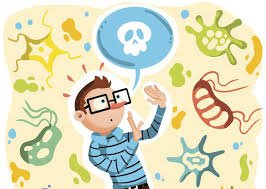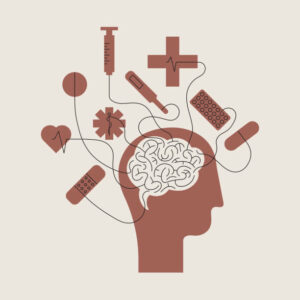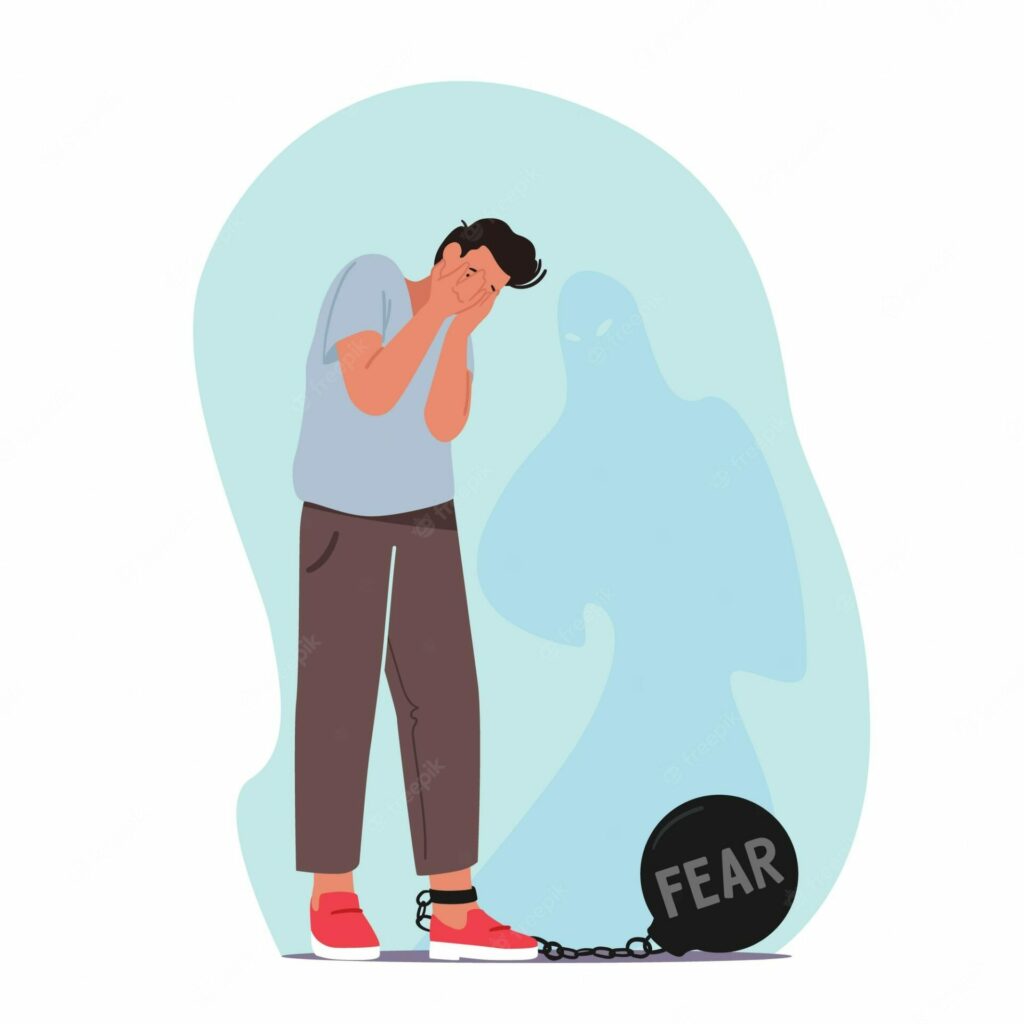Millions of people suffer from illness anxiety disorder (IAD), an intense fear of becoming ill. People with IAD often spend hours each day worrying about their health and often have intrusive thoughts about getting sick. While it is normal to worry about your health from time to time, people with IAD take their fears to the extreme. If you are struggling with IAD, it is important to get help. In this blog post, we will discuss the symptoms, causes, and treatment options for IAD.
Contents
Defining Illness Anxiety Disorder
 We all know the feeling of anxiety. It’s that feeling you get when you’re about to take a test, or when you’re giving a presentation. For most of us, anxiety is a normal and even healthy emotion.
We all know the feeling of anxiety. It’s that feeling you get when you’re about to take a test, or when you’re giving a presentation. For most of us, anxiety is a normal and even healthy emotion.
It is also not common for us to worry about our health and well-being. It has especially become more prevalent in recent years with the rise of COVID-19. We are constantly bombarded with images and stories of people who have become sick or have died from illnesses. This can trigger our own fears and worries about our health. However, for some people, anxiety can be much more intense and debilitating.
This is especially true for those who suffer from illness anxiety disorder. IAD is a type of anxiety disorder that is characterized by an excessive and irrational fear of illness. People with IAD often worry that they are sick, or that they will become sick in the future. They may also have intrusive thoughts about their health and spend hours each day researching their symptoms online. While it is normal to worry about your health from time to time, people with IAD take their fears to the extreme.
It is essential to note that IAD is different from hypochondria. Hypochondria is a disorder characterized by the belief that you are sick, even when there is no medical evidence to support this. People with IAD, on the other hand, may not necessarily believe that they are ill, but they are still extremely afraid of becoming sick.
Signs And Symptoms

Illness anxiety disorder is a serious condition that can have a major impact on your life. If you are struggling with IAD, you may encounter the following.
- Constantly worry about your health
- Spend hours researching your symptoms online
- Avoid going to the doctor for fear of receiving a diagnosis
- Constantly check your body for signs of illness
- Make multiple doctor’s appointments
- Avoid activities that you think may make you sick
- Miss work or school due to illness anxiety
- Have difficulty concentrating or completing tasks
- Isolate yourself from friends and family
- Experience physical symptoms because of the anxiety
- Be preoccupied with thoughts of death or dying
This is only a blueprint of what this disorder might entail. The real experience is different for everyone.
Causes And Risk Factors
There is no one specific cause of illness anxiety disorder. It is often the result of a combination of psychological, physical, and social factors.
Physical factors
Illness anxiety disorder may be caused by a previous experience with illness. If you have had a serious illness in the past, you may be more likely to develop IAD. This is because you may have a heightened fear of becoming ill again. Even with an ongoing physical illness, you may be at risk for IAD. This is because the anxiety and stress of living with a chronic illness can trigger IAD.
Moreover, there are certain procedures that may increase your risk of developing IAD. These include procedures that are invasive or have a high risk of complications. For example, a biopsy is a medical procedure that involves taking a sample of tissue from the body. This can be a very anxiety-provoking experience for some people. Certain medications can also cause IAD. Some of these medications are used to treat anxiety and depression. Others are used to treat chronic illnesses. For example, corticosteroids are a type of medication that is often used to treat inflammation. However, they can also cause side effects such as weight gain, mood swings, and insomnia. These side effects can trigger IAD in some people.
Psychological factors
 Our minds are the main drivers of our emotions and behaviors. As such, it is not surprising that psychological factors can play a role in the development of IAD. One of the most common psychological factors that contribute to IAD is anxiety. People who have anxiety are more likely to develop IAD than those who do not suffer from anxiety. This is because anxiety can cause us to focus on our physical health and pay close attention to any potential symptoms.
Our minds are the main drivers of our emotions and behaviors. As such, it is not surprising that psychological factors can play a role in the development of IAD. One of the most common psychological factors that contribute to IAD is anxiety. People who have anxiety are more likely to develop IAD than those who do not suffer from anxiety. This is because anxiety can cause us to focus on our physical health and pay close attention to any potential symptoms.
In addition, certain personality traits may also increase your risk of IAD. For example, people who are perfectionists or who have a lot of self-doubts are more likely to develop IAD. This is because these personality traits can lead to anxiety about one’s health. Moreover, trauma is a forever thing. It can leave us feeling scared, alone, and helpless. These feelings can lead to IAD.
Another way our psychological functions contribute to IAD is through our thought processes. People with IAD tend to have negative, distorted, and irrational thoughts about their health. For example, they may believe that a small symptom is a sign of a serious illness. Or, they may think that their doctor is not taking their symptoms seriously. These thoughts can lead to a great deal of anxiety and stress.
Social factors
The way we are raised can also play a role in the development of IAD. For example, if you were raised by parents who were constantly worried about their health, you may be more likely to develop IAD. This is because you may have learned to worry about your health from them. Similarly, excessive media exposure to the sick and the dying can also trigger IAD. This is because seeing others suffer from illness can make us worry that we will also become ill.
Another way our social environment can contribute to IAD is through our relationships. People who have a history of stressful or traumatic relationships are more likely to develop IAD. This is because these types of relationships can lead to feelings of insecurity and anxiety.
One may develop illness anxiety disorder due to a combination of psychological, social, and biological factors. It is possible to experience IAD even if you do not have a history of anxiety or any other mental health disorder.
Link With Other Disorders
By now, you might have noticed a pattern in the symptoms of IAD. Many of them are also common in other anxiety disorders. This is not a coincidence. In fact, IAD is often comorbid with other anxiety disorders, such as generalized anxiety disorder (GAD) and panic disorder.
Comorbidity is the presence of two or more disorders at the same time. Having IAD increases your risk of also suffering from another anxiety disorder. This is because the symptoms of one disorder can trigger the symptoms of another.
- For example, if you have IAD and you avoid going to the doctor out of fear of receiving a diagnosis, this can lead to health anxiety. Health anxiety is when you worry excessively about your health, even when there is no reason to. This can cause you to miss work or school, as well as isolate yourself from friends and family.
- Similarly, OCD, also popularly known as “germaphobia”, is another disorder that is often comorbid with IAD. OCD is an anxiety disorder characterized by intrusive and unwanted thoughts (obsessions) that lead to compulsions (ritualistic behaviors that are performed in an attempt to relieve the anxiety).
It’s important to note that comorbidity is different from dual diagnosis. Dual diagnosis occurs when someone suffers from a mental disorder and a substance abuse problem at the same time.
Consequences
 The consequences and causes of IAD are interconnected. The psychological and social factors that contribute to IAD can also lead to its consequences. The consequences of IAD can also be physical. Below is a list of all the impacts and behaviors of IAD:
The consequences and causes of IAD are interconnected. The psychological and social factors that contribute to IAD can also lead to its consequences. The consequences of IAD can also be physical. Below is a list of all the impacts and behaviors of IAD:
- Preoccupation with symptoms and health
- Avoidance of activities for fear of triggering symptoms
- Increased anxiety and stress
- Missed work or school
- Isolation from friends and family
- Interference in relationships
- Financial problems
- Medical complications
- Intrusive and unwanted thoughts about illness
- Compulsions (ritualistic behaviors)
- Substance abuse
- Dual diagnosis (mental disorder and substance abuse)
- Sleep problems
- Fatigue
- Loss of appetite
- Headaches
- Digestive problems
- Muscle tension
- Nervousness
- Sweating
- Shortness of breath
- Heart palpitations
- Panic attacks
As you can see, IAD can have a significant impact on your life. If you think you may be suffering from IAD, it’s important to seek help from a mental health professional.
Ways To Manage
The good news is that IAD is treatable. The first step is to see a mental health professional, such as a therapist or counselor. They will be able to diagnose you and create a treatment plan.
Professional help
Professional intervention is a very important part of managing IAD. This is because IAD can be difficult to manage on your own. A therapist will be able to help you understand your disorder and develop healthy coping mechanisms.
- Cognitive-behavioral therapy (CBT) is a type of therapy that has been found to be particularly effective in treating IAD. CBT focuses on changing the way you think about your illness. This, in turn, will change the way you behave. Exposure therapy is a type of CBT that can be especially helpful in treating IAD. This therapy involves gradually exposing you to the things you are afraid of, such as needles or blood tests.
- In some cases, medication may also be prescribed. The most common type of medication used to treat IAD is antidepressants. Antidepressants are not just for treating depression. They can also be effective in treating anxiety disorders. Other types of medications that might be prescribed include beta-blockers and anti-anxiety medication.
If you’re constantly worried about your health, to the point where it’s impacting your quality of life, it might be time to seek help. There’s nothing wrong with being cautious about your health. In fact, it’s probably a good thing. But when your anxiety about your health starts to interfere with your daily life, it might be time to seek help
Self-help strategies
 In addition to professional help, there are also things you can do on your own to manage IAD. One of the most important things you can do is to practice self-help. There are a number of self-help strategies that can be effective in managing IAD. Some of these include the following.
In addition to professional help, there are also things you can do on your own to manage IAD. One of the most important things you can do is to practice self-help. There are a number of self-help strategies that can be effective in managing IAD. Some of these include the following.
- Challenging negative thoughts: This involves identifying your negative thoughts and then challenging them. For example, if you think “I’m going to get sick and die”, you would challenge this thought by asking yourself “What evidence do I have for this?”.
- Keeping track of triggers: This involves keeping track of what triggers your anxiety. What are the things that make your anxiety about your health worse? Once you know what your triggers are, you can start to avoid them.
- Relaxation techniques: There are a number of different relaxation techniques that can be helpful in managing anxiety. Some of these include deep breathing, progressive muscle relaxation, and meditation.
- Exercise: Exercise has a number of benefits, both physical and mental. It can help to reduce stress and anxiety, and improve your overall mood.
- Eat a healthy diet: Eating a healthy diet is important for both your physical and mental health. Be sure to eat plenty of fruits, vegetables, and whole grains. Avoid sugary and processed foods.
- Get enough sleep: Getting enough sleep is crucial for both your physical and mental health. Be sure to get at least seven to eight hours of sleep each night.
- Limit alcohol and caffeine: Alcohol and caffeine can both contribute to anxiety and make it worse. It’s important to limit your intake of both of these substances.
All of these self-help strategies can be helpful in managing IAD. However, it’s important to remember that self-help is not a substitute for professional help. If you are struggling to manage your IAD on your own, be sure to seek professional help.
Conclusion
To conclude the above, IAD is a disorder that is often misunderstood. It can be difficult to manage on your own, but there are things you can do to help. With the proper treatment, IAD can be managed. If you think you might have IAD, be sure to seek professional help.
If you or someone you know is looking for psychological help, Therapy Mantra is here for you. We are the leading providers of online therapy and counseling. Our team of highly trained and experienced therapists can provide assistance at the most affordable rates. Contact us today to learn more about our services. You may also visit our website to book an online therapy session or download our free Android or iOS app for more information.


